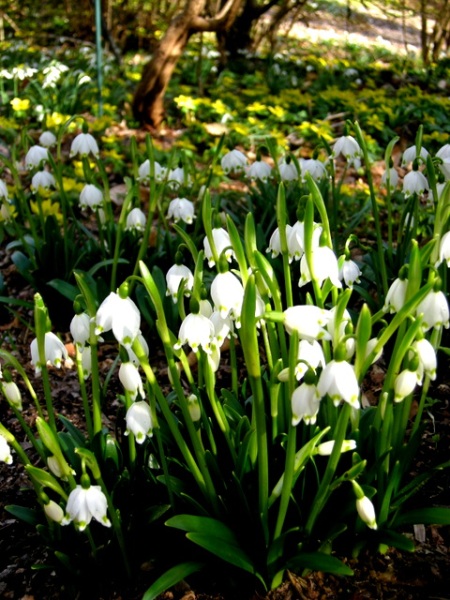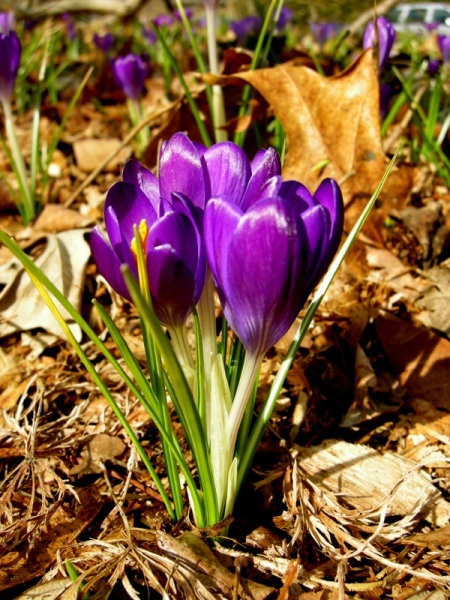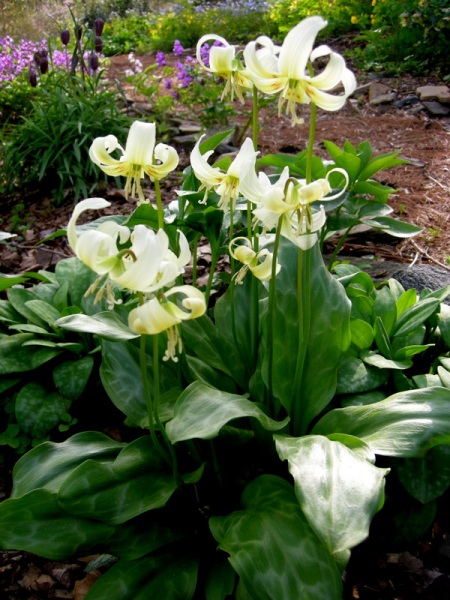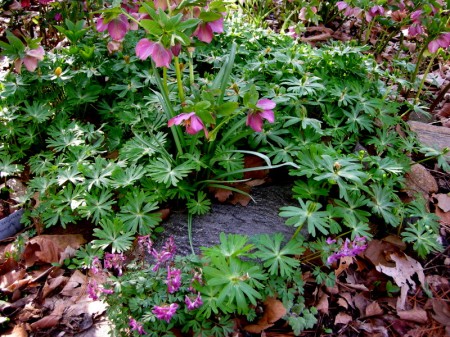 ‘Viridapice’ snowdrops (photo sent to me by the amazing Joan L)
‘Viridapice’ snowdrops (photo sent to me by the amazing Joan L)
Your comments on my last post, Trees and Shrubs for Early Color, click here to read, inspired me to write more with the goal of giving readers a bright spot during what is one of the grimmest times in our nation’s history. Please encourage all your gardening friends to read my blog. And let’s make it even more interactive. Leave comments about your experiences with the plants profiled or recommend similar plants and ask questions, nothing is too basic. There is a wealth of knowledge in the gardening community that we can all share here.
The photos below are of flowering bulbs that provide late winter and very early spring color. They are easy to grow, inexpensive to buy, and multiply readily.
I am dedicating this post to New York City Police Officer Tim G., whom we have known his whole life, and his fellow officers who continue to serve even though over 900 of them have tested positive for coronavirus. And to the 11,000 health care workers who have contracted the virus in Spain. In the face of their dedication, any sacrifice that we are asked to make seems trivial. Stay home to save lives.
Nursery News: Carolyn’s Shade Gardens is a retail nursery located in Bryn Mawr, PA, specializing in showy, colorful, and unusual plants for shade. The only plants that we ship are snowdrops within the US. For catalogues and announcements of local events, please send your full name, mailing address, and cell number to carolyn@carolynsshadegardens.com and indicate whether you are interested in snowdrops. Click here to get to the home page of our website for catalogues and information about our nursery and to subscribe to our blog.
. It is not going to surprise anyone who reads this blog that snowdrops, Galanthus, are my favorite bulb—I explain why in my post Classic Snowdrops, click here to read. This is ‘Kite’, a large and elegant snowdrop that has the unique ability to produce twin flowers (two flowers on one stem).
It is not going to surprise anyone who reads this blog that snowdrops, Galanthus, are my favorite bulb—I explain why in my post Classic Snowdrops, click here to read. This is ‘Kite’, a large and elegant snowdrop that has the unique ability to produce twin flowers (two flowers on one stem).
.
 Yes, snowdrops can be yellow. A customer sent me this photo of the lovely ‘Wendy’s Gold’.
Yes, snowdrops can be yellow. A customer sent me this photo of the lovely ‘Wendy’s Gold’.
.
.
 Everytime it gets warm enough during the winter for honeybees to fly, they swarm onto the snowdrops. This honeybee on ‘Straffan’ has collected an impressive amount of bright orange pollen.
Everytime it gets warm enough during the winter for honeybees to fly, they swarm onto the snowdrops. This honeybee on ‘Straffan’ has collected an impressive amount of bright orange pollen.
.
 Winter-blooming hardy cyclamen, C. coum, starts blooming in early January and often continues through March. This photo shows our last blooming stand on March 24.
Winter-blooming hardy cyclamen, C. coum, starts blooming in early January and often continues through March. This photo shows our last blooming stand on March 24.
.
 The winter aconite, Eranthis hyemalis, along our woodland path flowers in February. It is interplanted with common snowdrops, G. nivalis, which in this photo taken February 12 are not open yet.
The winter aconite, Eranthis hyemalis, along our woodland path flowers in February. It is interplanted with common snowdrops, G. nivalis, which in this photo taken February 12 are not open yet.
.
 Siberian squill, Scilla siberica, blooms in the most amazing color of blue in February and March. It is still in bloom today.
Siberian squill, Scilla siberica, blooms in the most amazing color of blue in February and March. It is still in bloom today.
. White Siberian squill, S. siberica ‘Alba’, is less common and really stands out in the winter landscape.
White Siberian squill, S. siberica ‘Alba’, is less common and really stands out in the winter landscape.
. ‘Beth Evans’ corydalis (top of photo), C. solida, also known as fumewort, blooms through out March. It is shown here with ‘Shell Pink’ lamium, which usually blooms in April but flowered early this year.
‘Beth Evans’ corydalis (top of photo), C. solida, also known as fumewort, blooms through out March. It is shown here with ‘Shell Pink’ lamium, which usually blooms in April but flowered early this year.
. Although we started with named cultivars of Corydalis solida, like ‘Beth Evans’ above, it has seeded through out our gardens in a multitude of beautiful colors. It is a bulbous corydalis and much more reliable than the herbaceous coydalis in blues and purples, which look glorious in pots but can’t withstand our hot summers. It goes dormant very quickly after it flowers.
Although we started with named cultivars of Corydalis solida, like ‘Beth Evans’ above, it has seeded through out our gardens in a multitude of beautiful colors. It is a bulbous corydalis and much more reliable than the herbaceous coydalis in blues and purples, which look glorious in pots but can’t withstand our hot summers. It goes dormant very quickly after it flowers.
.
 In the last post, I showed glory-of-the-snow, Chionodoxa forbesii, under our star magnolis. Its sky blue flowers look up and have an elegant white center.
In the last post, I showed glory-of-the-snow, Chionodoxa forbesii, under our star magnolis. Its sky blue flowers look up and have an elegant white center.
.
 Glory-of-the-snow comes in pink too, C. forbesii ‘Pink Giant’.
Glory-of-the-snow comes in pink too, C. forbesii ‘Pink Giant’.
.
 I especially like this white glory-of-the-snow, C. luciliae ‘Alba’, because it shows up so well in the winter garden.
I especially like this white glory-of-the-snow, C. luciliae ‘Alba’, because it shows up so well in the winter garden.
.
 ‘Charmer’ Greek windflower, Anemone blanda, was new for us last year and is quite striking and unusual. We have had the blue and white forms seeding happily in our woodland for years.
‘Charmer’ Greek windflower, Anemone blanda, was new for us last year and is quite striking and unusual. We have had the blue and white forms seeding happily in our woodland for years.
.
 Two-toned grape hyacinth, Muscari latifolium, combines pale and dark blue in a single flower. There are many forms of grape hyacinth, but this is my favorite.
Two-toned grape hyacinth, Muscari latifolium, combines pale and dark blue in a single flower. There are many forms of grape hyacinth, but this is my favorite.
.
 A harbinger of things to come, Anemone x seemanii, European wood anemone, blooms in March, earlier than all my other wood anemones, which generally flower in April. I hope to include more of them in a later post.
A harbinger of things to come, Anemone x seemanii, European wood anemone, blooms in March, earlier than all my other wood anemones, which generally flower in April. I hope to include more of them in a later post.
.
 I have dozens of varieties of daffodils, Narcissus, planted all over the garden. I am enjoying them more than ever this year, especially this early-blooming form right outside my front door whose name is lost in the mists of time.
I have dozens of varieties of daffodils, Narcissus, planted all over the garden. I am enjoying them more than ever this year, especially this early-blooming form right outside my front door whose name is lost in the mists of time.
My intent is to post on the blog more than once a week. You can provide inspiration to me and other readers by posting comments about your own experience with these plants or other late winter bulbs. Blogs are a lot more fun for everyone, especially the writer, when they are interactive. Scroll down to the end of the page to the box where it says “Leave a Reply” and start typing—-it’s easy!
Carolyn
Notes: Every word that appears in orange on my blog is a link that you can click for more information. If you want to return to my blog’s homepage to access the sidebar information (catalogues, previous articles, etc.) or to subscribe to my blog, just click here.


































































